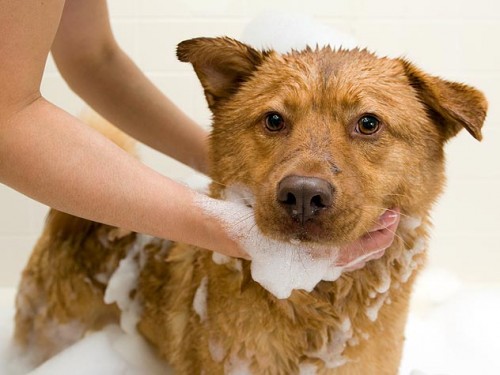Hypoallergenic Dog Food Recipe
Determining the Allergy
Before you can create hypoallergenic dog food, you must determine the ingredients your dog is allergic or intolerant to. Your veterinarian may suggest an elimination diet, which will initially contain two ingredients, such as turkey and sweet potatoes. You feed this simple diet and watch for allergy symptom improvement. After a period, you and the vet will add ingredients, one at a time. With each addition, you monitor for allergy symptoms. When an ingredient triggers an allergic reaction, you’ve identified an ingredient you’ll want to eliminate from your pet’s diet.
Common Dog Allergies
According to Susan Wynn, former president of the American Holistic Veterinary Medical Association, 10 percent of dog allergy cases are due to food. Symptoms include gastrointestinal issues, ear inflammation, diarrhea, vomiting and itchy skin. Beef, dairy, wheat, eggs, chicken, lamb, soy, pork, rabbit and fish are the most common ingredients responsible for dog allergies.
Ingredient Substitutions
Once you have determined an ingredient your dog is allergic to, seek suitable substitutions. If beef or chicken causes allergic reactions in your dog, use turkey or lamb instead. If dairy is an issue, look for lactose-free recipes. For wheat allergies, avoid recipes with flour, or substitute rice flour or rolled oats in its place.
Basic Recipe
For a basic recipe, add 1 cup of brown or white rice to 2 cups or water in a slow cooker. Add 1 to 2 cups of assorted vegetables such as sweet potatoes, green beans or carrots. Top with a pound of meat protein, such as two chicken breasts or a pound of lean ground beef. Cook on low for 8 hours or high for 5 hours.
Considerations
When making homemade dog food, it is essential that you meet your dog’s nutritional requirements. Discuss your recipe ideas with your veterinarian or a canine nutritionist to ensure your dog meets his nutritional requirements with your home-cooked diet. Armed with your recipes and knowledge of your dog’s dietary needs, your trusted vet will advise you on serving size, supplements and other tweaks.
How to Give Your Dog a Bath
As much as we all love for our furry friends to smell fresh and clean, getting to that point isn’t always easy. Dogs are rarely excited to jump into the bathtub for a good scrub. Bathing fearful dogs might be better handled by a professional groomer or your veterinary office. But if you decide to wade in, here are some helpful hints.
GETTING (YOU) READY

GETTING (FIDO) READY
Trimming your pet’s nails prior to bath time will not only give your dog better footing, it will also help protect your skin in case he tries to make a break for it. Now, bring the dog into the bathroom and close the door behind you — catching a wet, soapy dog running down your hallway is no easy task! Give praise and treats to make him comfortable in the bathroom before you try to get him into the tub. If you’re able to, gently putting a cotton ball in each ear can help keep water out — just be sure to remove them when you’re finished! Also, to help keep shampoo from irritating his eyes, you can put a drop of mineral oil in each one.
BRING ON THE SUDS
Dogs are unlikely to get into the tub willingly. For bigger dogs, a second person to help you get Fido into the bath can help avoid straining your back. Make sure water isn’t too hot or too cold. Let your dog hear and then gently feel the water before going full-speed ahead with the bath. Start shampooing your dog’s shoulders and then move out from there. Be gentle around the face and any sensitive areas but be sure you get down to the undercoat. Read the directions on the shampoo bottle carefully to ensure proper usage. Rinse out all the shampoo, using your fingers to make sure you get through the undercoat to avoid subsequent irritation. This is where a detachable showerhead or bowl comes in handy to be sure bigger dogs get rinsed thoroughly.
NO MORE TANGLES
After the shampoo has been completely rinsed out, you can apply conditioner, if desired. Follow the directions on the bottle because some products need to sit on the coat for several minutes. If you have a particularly squirmy dog, you’ll want to find a fast-acting formula. Once you have finished the bath, it is time to dry your pooch. Towel dry as much as possible in the bathroom. For dogs with longer coats, you may want to use a blow dryer set on low. Before the dog leaves the bathroom, brush his coat out thoroughly because the bath will loosen up a lot of fur, which is better contained in the bathroom than all over the house. Many dogs get “after-bath-crazies,” so hold onto your hat and let ‘em run!





